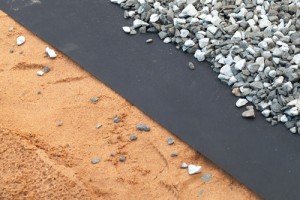There are a variety of applications for geotextiles, but most fall under the broad umbrella erosion control, soil stability and drainage. However, there’s a choice between woven and non-woven geotextiles and an advantage to each depending on the job being done. Here’s a rundown of what each category means, and what types of projects are a best fit for each.
Woven Geotextiles
As you might have guessed, this category of geotextiles is manufactured by weaving. Individual threads, be it monofilaments, fibrillated yarns, slit films or other material, are woven together on a loom one large, uniform piece. This process gives woven geotextiles a high load capacity, which makes them good for applications like road construction. Weaving threads or films together means these geotextiles aren’t very porous, which makes them a poor fit for projects where drainage is important. That same characteristic does make them ideal for some erosion control projects where water must be passed over a surface without draining through to the soil below. Woven geotextiles will also resist corrosion and hold up for long-term applications.
Non-woven Geotextiles
Rather than weaving together fabric on a loom, non-woven geotextiles are manufactured by bonding materials together, either through chemical or heat, needle punching or other methods. They’re made of synthetics and most often used in filter or separation applications. Non-woven geotextiles typically aren’t as good of a fit for stabilization or reinforcement projects. You’ll often find them protecting geomembrane lining systems from interior and exterior penetrations. The non-woven geotextile will break down faster than their woven counterparts. But, for projects where pooling water is a major concern, non-woven geotextiles are likely the right choice.
Whatever your geotextile needs, we at Maxwell Supply in Tulsa have the knowledge and products to meet them. Stop by and see us or give us a call today.
